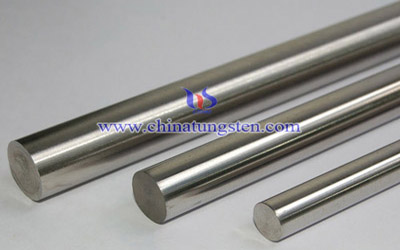2013 World Darts Championship Second Round of The Hamilton vs Barnett
- Details
- Category: Tungsten Information
- Published on Tuesday, 22 October 2013 10:42
2013 World Darts Championship second round of the Hamilton vs Barnett game video.
Tungsten Alloy Manufacturer & Supplier: Chinatungsten Online - http://www.tungsten-alloy.com
Tel.: 86 592 5129696; Fax: 86 592 5129797
Email: sales@chinatungsten.com;sales@xiamentungsten.com
Tungsten & Molybdenum Information Bank: http://i.chinatungsten.com
Tungsten News & Tungsten Prices, 3G Version: http://3g.chinatungsten.com
Molybdenum News & Molybdenum Price: http://news.molybdenum.com.cn
Tungsten Alloy Swaging Rod for Spike
- Details
- Category: Tungsten Information
- Published on Tuesday, 22 October 2013 10:34
Tungsten alloy swaging rod consists of W-Ni-Fe, W-Ni-Cu or W-Ni-Cu-Fe. Tungsten alloy swaging rod is made of tungsten alloy rod. After being swaged, the ultimate stensile strength can reach 1200 MPa or even 1400MPa. Tungsten alloy swaging rod is widely used in military industries. The warhead of Spike adopted tungsten alloy swaging rod.
Spike is a fourth generation man-portable fire-and-forget anti-tank guided missile and anti-personnel missile with a tandem-charged HEAT warhead, developed and designed by the Israeli company Rafael Advanced Defense Systems and in service with a number of nations.
With tungsten alloy swaging rod, Nimrod can penetrate armor easily to destroy armor vehicles or tanks.

Tungsten Heavy Alloy Manufacturer & Supplier: Chinatungsten Online - http://www.tungsten-alloy.com
Tel.: 86 592 5129696; Fax: 86 592 5129797
Email: sales@chinatungsten.com
Tungsten & Molybdenum Information Bank: http://i.chinatungsten.com
Tungsten News & Tungsten Prices, 3G Version: http://3g.chinatungsten.com
Molybdenum News & Molybdenum Price: http://news.molybdenum.com.cn
2013 World Darts Championship Second Round G Anderson vs Bowles
- Details
- Category: Tungsten Information
- Published on Tuesday, 22 October 2013 10:27
2013 World Darts Championship second round G Anderson vs Bowles game video.
Tungsten Alloy Manufacturer & Supplier: Chinatungsten Online - http://www.tungsten-alloy.com
Tel.: 86 592 5129696; Fax: 86 592 5129797
Email: sales@chinatungsten.com;sales@xiamentungsten.com
Tungsten & Molybdenum Information Bank: http://i.chinatungsten.com
Tungsten News & Tungsten Prices, 3G Version: http://3g.chinatungsten.com
Molybdenum News & Molybdenum Price: http://news.molybdenum.com.cn
2013 PDC World Darts Championship first round Voort vs Kellet Video Game
- Details
- Category: Tungsten Information
- Published on Tuesday, 22 October 2013 10:23
2013 PDC World Darts Championship first round Voort vs Kellet video game.
Tungsten Alloy Manufacturer & Supplier: Chinatungsten Online - http://www.tungsten-alloy.com
Tel.: 86 592 5129696; Fax: 86 592 5129797
Email: sales@chinatungsten.com;sales@xiamentungsten.com
Tungsten & Molybdenum Information Bank: http://i.chinatungsten.com
Tungsten News & Tungsten Prices, 3G Version: http://3g.chinatungsten.com
Molybdenum News & Molybdenum Price: http://news.molybdenum.com.cn
2013 World Darts Championship Quarterfinals Wade vs Newton
- Details
- Category: Tungsten Information
- Published on Tuesday, 22 October 2013 10:21
2013 World Darts Championship quarterfinals Wade vs Newton game video.
Tungsten Alloy Manufacturer & Supplier: Chinatungsten Online - http://www.tungsten-alloy.com
Tel.: 86 592 5129696; Fax: 86 592 5129797
Email: sales@chinatungsten.com;sales@xiamentungsten.com
Tungsten & Molybdenum Information Bank: http://i.chinatungsten.com
Tungsten News & Tungsten Prices, 3G Version: http://3g.chinatungsten.com
Molybdenum News & Molybdenum Price: http://news.molybdenum.com.cn
2013 PDC World Darts Championship Quarterfinals Whitlock vs Barneveld
- Details
- Category: Tungsten Information
- Published on Tuesday, 22 October 2013 10:14
2013 PDC World Darts Championship Quarterfinals Whitlock vs Barneveld game video.
Tungsten Alloy Manufacturer & Supplier: Chinatungsten Online - http://www.tungsten-alloy.com
Tel.: 86 592 5129696; Fax: 86 592 5129797
Email: sales@chinatungsten.com;sales@xiamentungsten.com
Tungsten & Molybdenum Information Bank: http://i.chinatungsten.com
Tungsten News & Tungsten Prices, 3G Version: http://3g.chinatungsten.com
Molybdenum News & Molybdenum Price: http://news.molybdenum.com.cn
2013 PDC World Darts Championship Quarterfinals Lewis vs Van Gerwen
- Details
- Category: Tungsten Information
- Published on Tuesday, 22 October 2013 10:12
2013 PDC World Darts Championship quarterfinals Lewis vs Van Gerwen game video.
Tungsten Alloy Manufacturer & Supplier: Chinatungsten Online - http://www.tungsten-alloy.com
Tel.: 86 592 5129696; Fax: 86 592 5129797
Email: sales@chinatungsten.com;sales@xiamentungsten.com
Tungsten & Molybdenum Information Bank: http://i.chinatungsten.com
Tungsten News & Tungsten Prices, 3G Version: http://3g.chinatungsten.com
Molybdenum News & Molybdenum Price: http://news.molybdenum.com.cn
Tungsten Alloy Swaging Rod for Nimrod
- Details
- Category: Tungsten Information
- Published on Tuesday, 22 October 2013 10:09
Tungsten alloy swaging rod consists of W-Ni-Fe, W-Ni-Cu or W-Ni-Cu-Fe. Tungsten alloy swaging rod is made of tungsten alloy rod. After being swaged, the ultimate stensile strength can reach 1200 MPa or even 1400MPa. Tungsten alloy swaging rod is widely used in military industries. The warhead of Nimrod adopted tungsten alloy swaging rod.
Nimrod is a long-range air-to-surface and surface-to-surface missile developed by Israel Aerospace Industries. While primarily designed for anti-tank use, it provides standoff strike capability against a variety of point targets such as APCs, ships, bunkers, personnel concentrations and guerrillas.
Nimrod has a semi-active laser guidance system, capable of day and night operation. Its flight trajectory can be set below obscuring cloud layers, while a forward scouting team uses a laser designator to direct it from up to 26 km behind.
With tungsten alloy swaging rod, Nimrod can penetrate armor easily to destroy armor vehicles or tanks.

Tungsten Heavy Alloy Manufacturer & Supplier: Chinatungsten Online - http://www.tungsten-alloy.com
Tel.: 86 592 5129696; Fax: 86 592 5129797
Email: sales@chinatungsten.com
Tungsten & Molybdenum Information Bank: http://i.chinatungsten.com
Tungsten News & Tungsten Prices, 3G Version: http://3g.chinatungsten.com
Molybdenum News & Molybdenum Price: http://news.molybdenum.com.cn
2013 PDC World Darts Championship Half Finals Van Gerwen vs Wade
- Details
- Category: Tungsten Information
- Published on Tuesday, 22 October 2013 10:08
2013PDC World Darts Championship half finals Van Gerwen vs Wade game video.
Tungsten Alloy Manufacturer & Supplier: Chinatungsten Online - http://www.tungsten-alloy.com
Tel.: 86 592 5129696; Fax: 86 592 5129797
Email: sales@chinatungsten.com;sales@xiamentungsten.com
Tungsten & Molybdenum Information Bank: http://i.chinatungsten.com
Tungsten News & Tungsten Prices, 3G Version: http://3g.chinatungsten.com
Molybdenum News & Molybdenum Price: http://news.molybdenum.com.cn
Differentiation Serious Non-Ferrous Metal Prices of Agricultural Products
- Details
- Category: Tungsten Information
- Published on Tuesday, 22 October 2013 10:05
Differentiation serious non-ferrous metal prices of agricultural products.
Tungsten Alloy Manufacturer & Supplier: Chinatungsten Online - http://www.tungsten-alloy.com
Tel.: 86 592 5129696; Fax: 86 592 5129797
Email: sales@chinatungsten.com;sales@xiamentungsten.com
Tungsten & Molybdenum Information Bank: http://i.chinatungsten.com
Tungsten News & Tungsten Prices, 3G Version: http://3g.chinatungsten.com
Molybdenum News & Molybdenum Price: http://news.molybdenum.com.cn


 sales@chinatungsten.com
sales@chinatungsten.com